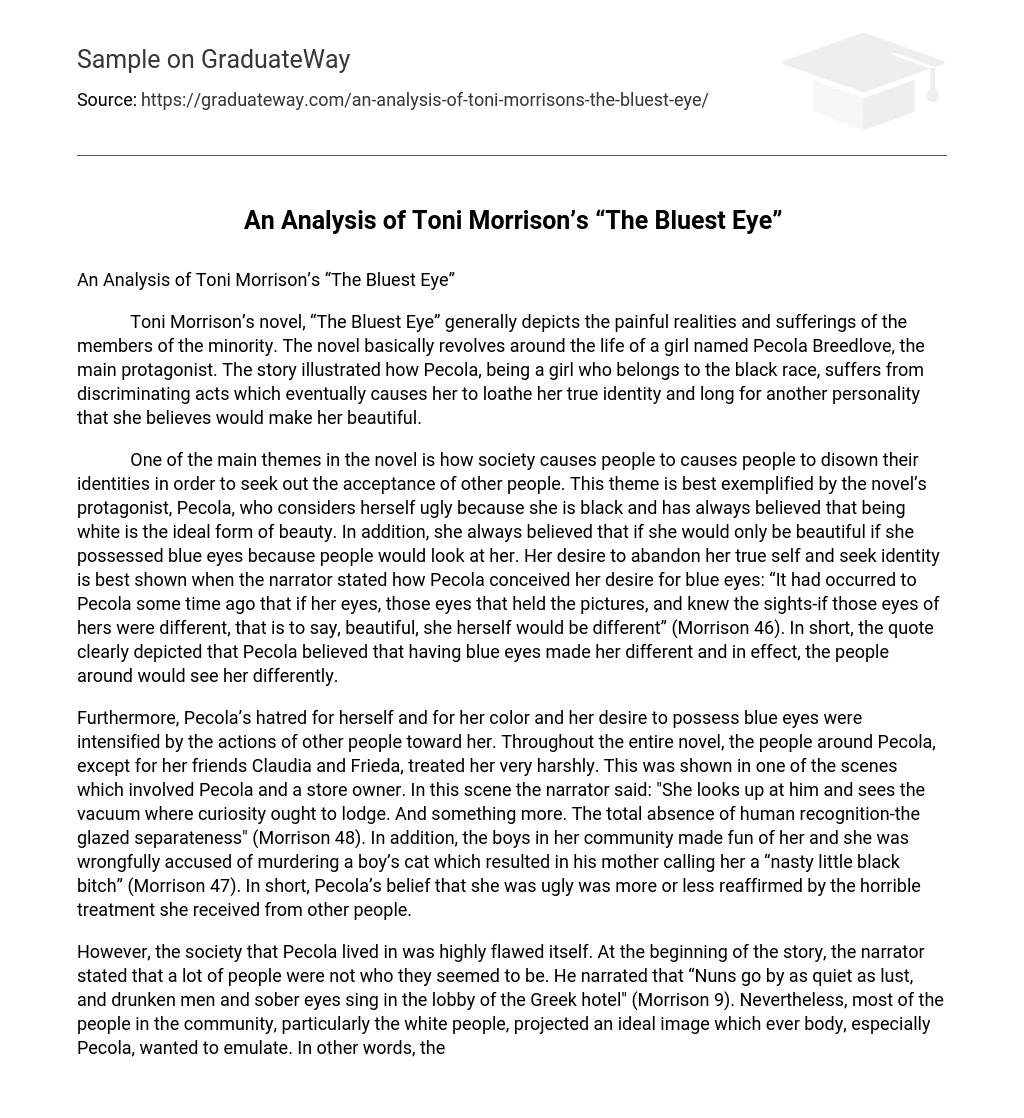Toni Morrison’s novel, “The Bluest Eye” generally depicts the painful realities and sufferings of the members of the minority. The novel basically revolves around the life of a girl named Pecola Breedlove, the main protagonist. The story illustrated how Pecola, being a girl who belongs to the black race, suffers from discriminating acts which eventually causes her to loathe her true identity and long for another personality that she believes would make her beautiful.
One of the main themes in the novel is how society causes people to causes people to disown their identities in order to seek out the acceptance of other people. This theme is best exemplified by the novel’s protagonist, Pecola, who considers herself ugly because she is black and has always believed that being white is the ideal form of beauty. In addition, she always believed that if she would only be beautiful if she possessed blue eyes because people would look at her. Her desire to abandon her true self and seek identity is best shown when the narrator stated how Pecola conceived her desire for blue eyes: “It had occurred to Pecola some time ago that if her eyes, those eyes that held the pictures, and knew the sights-if those eyes of hers were different, that is to say, beautiful, she herself would be different” (Morrison 46). In short, the quote clearly depicted that Pecola believed that having blue eyes made her different and in effect, the people around would see her differently.
Furthermore, Pecola’s hatred for herself and for her color and her desire to possess blue eyes were intensified by the actions of other people toward her. Throughout the entire novel, the people around Pecola, except for her friends Claudia and Frieda, treated her very harshly. This was shown in one of the scenes which involved Pecola and a store owner. In this scene the narrator said: “She looks up at him and sees the vacuum where curiosity ought to lodge. And something more. The total absence of human recognition-the glazed separateness” (Morrison 48). In addition, the boys in her community made fun of her and she was wrongfully accused of murdering a boy’s cat which resulted in his mother calling her a “nasty little black bitch” (Morrison 47). In short, Pecola’s belief that she was ugly was more or less reaffirmed by the horrible treatment she received from other people.
However, the society that Pecola lived in was highly flawed itself. At the beginning of the story, the narrator stated that a lot of people were not who they seemed to be. He narrated that “Nuns go by as quiet as lust, and drunken men and sober eyes sing in the lobby of the Greek hotel” (Morrison 9). Nevertheless, most of the people in the community, particularly the white people, projected an ideal image which ever body, especially Pecola, wanted to emulate. In other words, the society sets the ideal standards of identity which its people should or are expected to follow. These ideal standards caused people like Pecola, who was discriminated and ridiculed most of the time, to disown any identity they might possess and seek one that conforms to the standards set by society. This is best shown when Claudia, who was depicted as a girl belonging to an below average family, narrated how she hated a white girl named Rosemary Villanucci, who acted as if she is entitled to the riches in life due to her social position. In Claudia’s narration she said, “We stare at her, wanting her bread, but more than that wanting to poke the arrogance out of her eyes and smash the pride of ownership that curls her chewing mouth” (Morrison 9).
In short, in a society, when people like Pecola and Claudia see the beauty and riches of other that they do not possess, they are compelled to seek out those characteristics and possessions for themselves. Seemingly, the society acts as a sole judge of its people and the epitome of how people should act. In the case of the society depicted in the novel, it was the white people who dictated the supposed norms in their community that caused Pecola, who is black, to follow those norms by desiring to have the bluest eyes which she believes would make her beautiful
Works Cited
Morrison, Toni. The Bluest Eye. New York: Plume, 2000.





